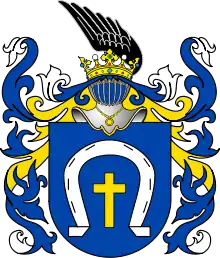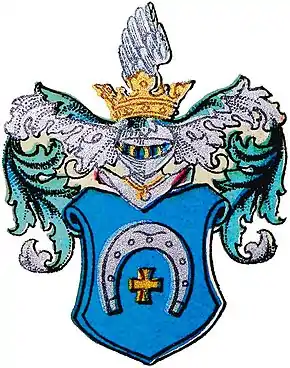| Tępa Podkowa | |
|---|---|
 | |
| Details | |
| Families | 39 families: Bilczyński, Brzezicki, Bulkowski, Chojecki, Chyżeński, Czubiński, Dobiesławski, Dobrowolski, Dymowski, Dymski, Dymski Smogor, Falboski, Falbowski, Gomolicki, Hamerski, Janiszowski, Łabędzki, Łomszycki, Mianowski, Modaliński, Modliński, Nacelewicz, Nacelowicz, Naszewski, Nechrowicz, Niszowski, Ostrowski, Rączkowski, Sachrowski, Sarszowski, Stabrowski, Straka, Szczepankowicz, Szumko, Trzetrzewiński, Wolski, Złotarzewski, Złotaszewski, Żychowski |

The original version of the coat of arms of the second half of the nineteenth century
Tępa Podkowa is a Polish coat of arms. It was used by several szlachta families in the times of the Polish–Lithuanian Commonwealth.
The name literally means "Dull Horseshoe".
History
Blazon
The blazon can be translated as: On a blue field an upright standing horseshoe with a golden cross in the center. Blue mantling with silver and gold. In the crown a black wing.
Notable bearers
The fictional characters of the knights Zbyszko of Bogdaniec and Maćko of Bogdaniec, the main characters in Henryk Sienkiewicz's The Teutonic Knights, are bearers of this coat of arms.
External links
- J. Lyčkoŭski. "Belarusian Nobility Coats of Arms". (in English)
- "Armorial of Belarusian Nobility". (in English)
See also
This article is issued from Wikipedia. The text is licensed under Creative Commons - Attribution - Sharealike. Additional terms may apply for the media files.